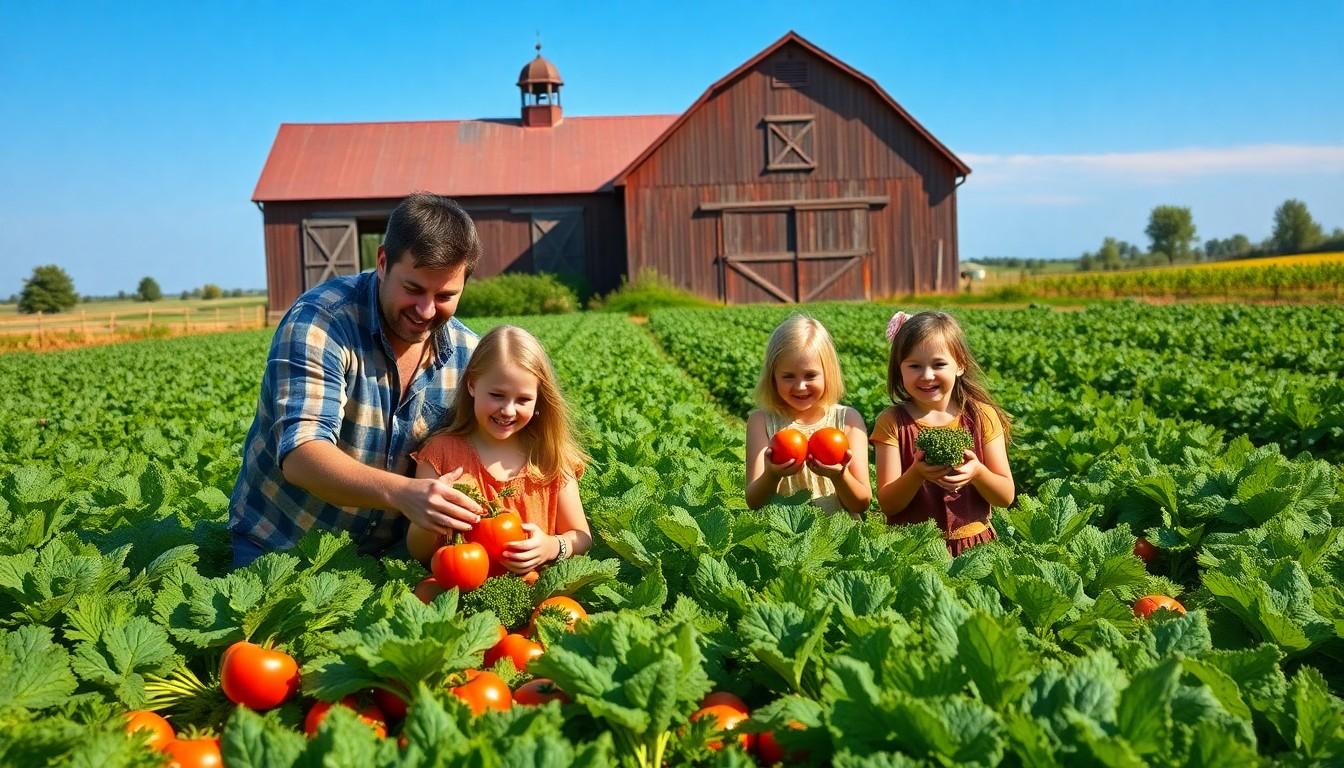Imagine swapping your crowded cityscape for rolling fields and fresh air, where the only traffic jam involves a few curious cows. Agritourism has become the ultimate escape for those craving a taste of the countryside while still enjoying the comforts of modern life. It’s not just a vacation; it’s an adventure that lets travelers immerse themselves in farming culture, taste farm-fresh produce, and maybe even get their hands a little dirty.
From picking strawberries to learning how to milk a goat, agritourism offers a unique blend of fun and education. It’s a chance to reconnect with nature and understand where food really comes from—spoiler alert: it’s not just the grocery store! As more people seek authentic experiences, agritourism is blossoming into a thriving industry that promises unforgettable memories and a few laughs along the way.
What Is Agritourism
Agritourism refers to the integration of agricultural operations with tourism activities. Visitors engage in on-farm experiences that foster a deeper understanding of agriculture and food production. Activities often include fruit picking, farm tours, and educational workshops.
Farmers open their gates to tourists, allowing them to explore sustainable practices and traditional farming techniques. Guests learn about seasonal crops, animal husbandry, and the challenges faced by modern farmers. Moreover, these experiences promote direct connections between consumers and their food sources.
Economic benefits arise from agritourism as it provides farmers an additional income stream. Rural economies gain from increased tourism, leading to jobs and business growth in related sectors, such as hospitality and dining. A 2020 study by the American Farm Bureau Federation highlighted that agritourism contributes approximately $2 billion annually to the U.S. economy.
Sampling local produce and participating in farm events offer visitors authentic culinary experiences. Farmers often showcase regional specialties, enhancing the culinary landscape for tourists. Engagement in these activities frequently leads to a renewed appreciation for food and farming practices.
Agritourism helps preserve agricultural heritage and encourages conservation efforts. Participants are often inspired to support local agriculture and sustainable practices after their experiences. As interest in agritourism continues to rise, more farms are adapting to meet the demands of tourists seeking educational and enjoyable agro-experiences.
Benefits of Agritourism

Agritourism provides significant advantages, influencing the economy and society.
Economic Impact
Agritourism generates approximately $2 billion annually for the U.S. economy. Many farmers benefit from diversifying their income through on-farm experiences, reducing reliance on traditional crop sales. Visitors frequently spend money on produce, workshops, and accommodations, contributing to local economies. Employment opportunities increase as farms expand to accommodate tourism. Additional income enables farmers to invest in sustainable practices, enhancing long-term farm viability.
Social Benefits
Agritourism fosters community connections and awareness about agriculture’s role in food systems. Visitors engage with farmers, gaining insight into farming challenges and methods. Educational programs raise awareness of sustainable practices, inspiring individuals to advocate for local agriculture. Participants often develop a greater appreciation for nature, leading to environmental stewardship. Families create lasting memories through hands-on experiences, strengthening bonds and encouraging outdoor activities.
Types of Agritourism Activities
Various agritourism activities provide unique experiences for visitors. Engaging with these activities fosters a deeper connection to agriculture and the countryside.
Farm Stays
Visitors can immerse themselves in farm life through farm stays. Accommodation on working farms allows guests to participate in daily routines such as feeding animals and harvesting crops. Engaging with farmers creates a personal connection to food production. Guests often enjoy home-cooked meals featuring farm-fresh ingredients. Family-style settings enhance the experience, fostering community and sharing stories. Many farms offer rustic cabins or cozy guesthouses, providing a tranquil escape from urban life.
Pick-Your-Own Experiences
Pick-your-own experiences offer visitors the chance to harvest fresh produce directly from the fields. Berries, apples, pumpkins, and flowers are common options available for picking. This hands-on opportunity not only promotes physical activity but also educates participants about seasonal crops. Families appreciate the fun and interaction, often capturing memories with photos. Local markets frequently sell the harvested items, supporting the farm’s economy. Such experiences encourage appreciation for agricultural practices and seasonal cycles.
Educational Tours
Educational tours present a valuable means for visitors to learn about farming and sustainability. Guided tours often cover topics like crop management, livestock care, and organic practices. Engaging presentations deepen understanding of where food comes from and the importance of sustainable practices. Many farms incorporate interactive elements, such as demonstrations and tastings. Field trips commonly attract schools, enhancing students’ learning experiences. Workshops on topics like canning or gardening provide practical skills that participants can take home.
Challenges in Agritourism
Agritourism faces various challenges that can impact its growth and sustainability. Understanding these obstacles is essential for farmers and entrepreneurs in the sector.
Regulation and Compliance
Regulatory requirements often complicate agritourism operations. Farmers must navigate local zoning laws, health regulations, and safety standards. Each state may impose different rules that affect how agritourism activities are implemented. Compliance with agricultural safety regulations is critical, particularly when accommodating guests on farms. Lost opportunities can result from failing to meet certification or liability standards. Investments in compliance training become necessary to avoid legal issues. Associations and local government programs sometimes offer resources to help farms address these challenges.
Seasonal Variability
Seasonal variability significantly affects agritourism experiences. Visitors often expect specific activities based on seasonal crops and events. For instance, fall may bring pumpkin picking while summer highlights berry harvesting. Farms face fluctuations in visitor numbers throughout the year. Lower attendance during off-peak seasons can lead to inconsistent income streams. Planning around these variations becomes crucial for financial stability. Effective marketing strategies promote diverse activities, encouraging year-round engagement. Additionally, diversifying offerings beyond agriculture helps attract visitors regardless of the season.

